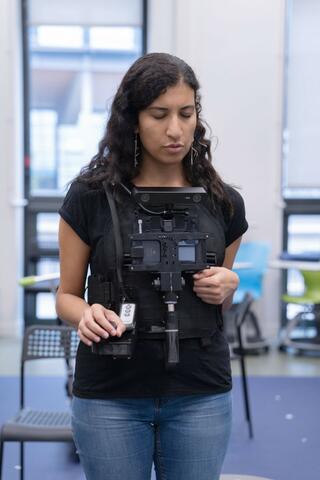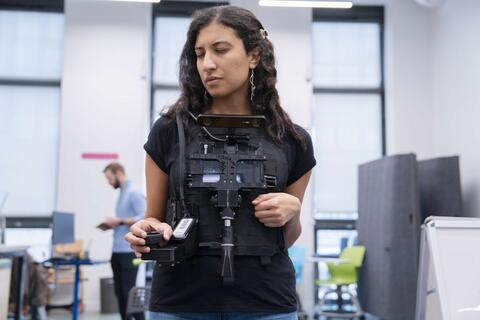
Salomé Nashed
Silver Medalist at Cybathlon 2024
The device facilitates my navigation by making my movements smoother.
Salomé Nashed, a visually impaired bioinformatics researcher, recently won the silver medal at the 2024 Cybathlon as a pilot for Team A-eye. A tenacious individual with a passion for life sciences, she has forged a path in research, earning a PhD in biology as well as the prestigious L'Oréal-UNESCO Young Talents for Women in Science Award in 2022. Committed to advancing technology for people with disabilities, this young researcher tells us about her inspiring journey, the challenges she faces, and the impact of this extraordinary international competition.
Can you tell us about your backgound?
Salomé Nashed: My journey is unusual for a visually impaired person because I chose to study biology, a highly visual field that relies heavily on graphs and diagrams. Driven by a love for life sciences, I started my studies in 2014 at Sorbonne University because I didn’t want my disability to prevent me from achieving my dream. In 2017, I obtained a dual bachelor’s degree in life sciences and public health innovation. Two years later, I completed a master’s in molecular and cellular biology with a focus on genetics and epigenetics. Self-taught in programming, I interned at the computational and quantitative biology lab at the Institute of Biology Paris Seine, which led me in 2019 to a PhD in genomics and genetics. I then pursued a postdoc in bioinformatics to train in high-throughput data analysis, evolutionary studies, and phylogeny. My goal now is to continue a career in research and teaching.
What motivated you to become Team A-eye's pilot for the Cybathlon?
S. N.: Project leaders Fabien Vérité and Ludovic Saint-Bauzel initially had another pilot, but that person wasn’t available for the full training period until the Cybathlon. They contacted the Student Health and Disability Services at Sorbonne University, who passed along my information. They explained they were developing a guidance system for visually impaired people and wanted my feedback as they prepared for the Cybathlon. This international competition, where each pilot must complete 10 challenges in 8 minutes before 3,000 people, aims to raise awareness about disabilities and promote technological innovation.
I was immediately drawn to the challenge, and Fabien and Ludovic struck me as compassionate, engaging, and attentive. I knew right away this would be an incredible journey with them. Today, I am honored to represent their impressive work and showcase their efforts in a competition that plays an essential role in raising awareness about disabilities in the research community.

Salomé Nashed, pilote de l'équipe A-eye, en cours d'entraînement pour le Cybathlon ©Sorbonne-Université
What were your initial impressions of testing the kinesthetic harness?
S. N.: The first time I tested the kinesthetic harness, I found it very intuitive. The joystick, which presses on the right or left side of my hand, feels like holding someone’s arm while they guide me. From my first attempts, I could easily follow the device's directions, which was very impressive.
I was surprised that even on the first use, the device enabled precise navigation. With this harness, I can avoid small obstacles and make very subtle movements, like sidestepping an object by shifting slightly left or right without even realizing it. The device’s precision in adjusting my path amazed me.
How does your experience influence the system’s development?
S. N.: As a pilot, I bring my experience as a visually impaired person. I am used to following a guide, so my background makes me more receptive to the information the device provides compared to someone who is not used to navigating without sight. This allows me to more easily identify issues and provide specific feedback.
Another crucial point is that, in addition to being a pilot, I am a researcher myself. When issues arise during training—like a bug in the code—the engineering team often has to review the program. Initially, they were anxious about making me wait, but I reassured them: in research, setbacks are normal, and testing is essential. When something doesn’t work, I’m curious about why. This creates productive exchanges and makes training sessions more relaxed and enjoyable for everyone.
What challenges do you face while preparing for the Cybathlon?
S. N.: Training sessions can sometimes last two to three hours and demand intense focus. There are often elements in the device’s development that we can’t anticipate until training begins. We encounter last-minute issues, but these unexpected adjustments are part of the process.
For me, the biggest challenge, both physically and mentally, is to be quick and effective on competition day. The Cybathlon involves 10 trials over 8 minutes, so I can’t afford to hesitate. I need complete trust in the device, to stay calm, and to maintain 100% focus.
How are you feeling as the competition approaches?
S. N.: The pressure is building since we have limited time left for training, and completing 10 challenges in 8 minutes leaves no room for mistakes. Some tasks are particularly complex, like walking on tiles of varying sizes without straying off the path. If I misstep, I’m disqualified from that challenge. The real test is speed. So yes, I’m apprehensive, but I’m also very excited. I look forward to this adventure with the A-eye team, a fantastic group of people I love working with and hope to keep collaborating with. I also look forward to meeting other international teams and discovering their solutions. It will be a time rich in exchanges and shared experiences.
Even if we don’t win, presenting our device and raising awareness will already be a great victory. But of course, I want to go as far as possible because I believe in the potential of this guidance system. I’d like the team’s two years of work to be recognized and highlighted. That’s why I want to give my very best!
In the long term, how might this device change your daily life?
S. N.: The device could significantly improve my mobility. It’s highly intuitive and helps me avoid obstacles that a white cane doesn’t always detect, like overhead signs or poles on Paris sidewalks that are difficult to maneuver around.
Cognitively, it’s also much less tiring than using a cane. With a cane, I need to identify obstacles and think about how to bypass them, which requires a lot of focus. The device’s kinesthetic feedback guides me directly left or right, greatly reducing mental strain. I no longer have to actively think about the route and obstacles to avoid, making movements smoother and less stressful.
Improvements are still needed, such as anticipating stairs, but the device already greatly facilitates navigation by reducing fatigue and making my movements smoother.
Interview by Justine Mathieu
Cybathlon Final in Photos
Salomé Nashed during the 2024 Cybathlon final. Photo by ETH Zurich / Cybathlon / Nicola Pitaro





